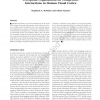Free Online Productivity Tools
i2Speak
i2Symbol
i2OCR
iTex2Img
iWeb2Print
iWeb2Shot
i2Type
iPdf2Split
iPdf2Merge
i2Bopomofo
i2Arabic
i2Style
i2Image
i2PDF
iLatex2Rtf
Sci2ools
JOCN
2010
2010
Defining the Units of Competition: Influences of Perceptual Organization on Competitive Interactions in Human Visual Cortex
Multiple stimuli that are present simultaneously in the visual field compete for neural representation. At the same time, however, multiple stimuli in cluttered scenes also undergo perceptual organization according to certain rules originally defined by the Gestalt psychologists such as similarity or proximity, thereby segmenting scenes into candidate objects. How can these two seemingly orthogonal neural processes that occur early in the visual processing stream be reconciled? One possibility is that competition occurs among perceptual groups rather than at the level of elements within a group. We probed this idea using fMRI by assessing competitive interactions across visual cortex in displays containing varying degrees of perceptual organization or perceptual grouping (Grp). In strong Grp displays, elements were arranged such that either an illusory figure or a group of collinear elements were present, whereas in weak Grp displays the same elements were arranged randomly. Competiti...
| Added | 19 May 2011 |
| Updated | 19 May 2011 |
| Type | Journal |
| Year | 2010 |
| Where | JOCN |
| Authors | Stephanie A. McMains, Sabine Kastner |
Comments (0)

